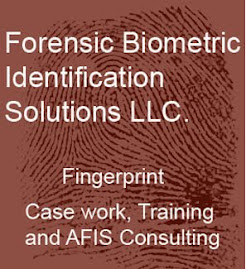Scientific research has concluded that it takes eight-to-twelve years of training for a talented player/athlete to reach elite levels. This is called the ten-year or 10,000 hour rule, which translates to slightly more than three hours of practice daily for ten years (Ericsson, et al., 1993; Ericsson and Charness, 1994, Bloom, 1985; Salmela et al., 1998).
Does this apply to latent fingerprint examiners? and how does this impact latent fingerprint accuracy? I think everyone will agree that today latent fingerprint examiners have the opportunity to identify many more latent fingerprints than in the past, largely due to the automated fingerprint identification systems. I would estimate that 20 to 30% of the cases identified in my Lab. were cold hits ( fingerprint suspects produced by the automated fingerprint identification system). In addition to the increase in latent fingerprint identifications, there has been a decrease in image quality of the fingerprint cards housed in state and federal databases (tenprint cards). Many fingerprint cards are still poorly acquired and the fingerprint card printers on the automated systems often don't produce a high quality image for fingerprint comparison. What does that mean for the latent fingerprint examiner? it means that today there are many more difficult latent fingerprint comparisons for the latent examiner. Are there more missed and bad fingerprint identifications today, unfortunately, yes. In addition to the increase in the number of latent fingerprints developed and searched , the automated fingerprint identification system computers find unusually close non-matching fingerprint suspects. To make a determination of identification today it will require a latent fingerprint examiner that has reached " elite levels", the individual with 10,000 hrs of fingerprint comparison work and training. Unfortunately many of the local agencies don't have the resources to develop the latent fingerprint examiner to the elite levels, often they develop a fingerprint examiner that is good at many functions (a jack of all trades). There are many fingerprint identifications that can be done by journeymen fingerprint examiners. When the latent fingerprint lift and fingerprint card are both good, the fingerprint examiner with limited experience is capable making a good decision. The problem for the journeyman fingerprint examiner is when the print lacks clarity and they are required to determine a level of tolerance for discrepancies. The answer of course is more fingerprint experience and training before the latent examiner is allowed to testify in court. Is the problem of more fingerprint comparison work before allowing the fingerprint examiner to testify in court being addressed? Unfortunately it is not and we can expect more Boston PD and L.A. PD Lab. situations from other agencies in the future. Some fingerprint programs that do appear to work are the FBI and the larger states which do allow the latent examiner to reach the elite levels of experience before they are allowed to testify in court. The FBI requires that latent fingerprint examiners make in the neighborhood of 250,000 comparisons before they are ready to testify in court. The larger state agencies, New York as an example, develop fingerprint examiners through the tenprint system as part of a career ladder. It usually takes a fingerprint examiner close to 10 yrs to work up through the system to get a chance to be a latent fingerprint examiner. Both of these systems produce excellent latent fingerprint examiners. Most PD's and smaller states, because of budgetary issues, aren't able to develop elite level latent fingerprint examiners and will become the LA or Boston storyies in the future.
Subscribe to:
Post Comments (Atom)






No comments:
Post a Comment